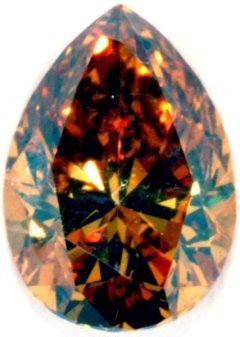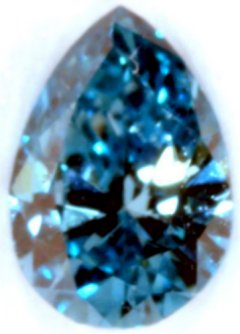| The Very Highest Quality Diamond Information... |
| Pear Shaped Diamonds |

|
|
|

|
|
|
A pear-shaped or oval gem, especially a diamond, cut in long triangular facets. [French, perhaps alteration (influenced by brillant, brilliant) of brignolette, diminutive of brignole, dried plum, from Brignoles, a town of southeast France.]We would have described a briolette as an elongated teardrop shape, with or without a drilled central hole, to be worn as a pendant, or a tremblant. Its facets are all rose cuts, and therofore generally triangular. The section of a briolette would normally be circular, be there is no reason thwy it could not be oval.
According to one website:
The Briolette Cut is a drop-shaped stone with triangular or diamond-shaped facets all the way around. There is no table, crown or pavilion. The more facets, the more brilliant the stone appears. The facets on a Briolette are all triangular in shape entirely covering the circular cross section of the stone. Briolette diamonds necklace Briolette diamonds are found in antique and estate jewelry from the Victorian, Edwardian and Art Deco eras. Briolettes are one of the earliest diamond cuts. In or about 1476 Lodewyk (Louis) van Berquem, a Flemish polisher of Bruges, introduced absolute symmetry in the design of facets. He cut stones in the shape known as pendeloque or briolette. Briolette cut diamonds also are being newly cut, especially in larger sizes like 10 to 12 carats, primarily in India. Even larger Briolettes, up to 50 carats, are being cut in New York City. Briolette loose diamonds Most Briolettes are cut from white rough, but colored diamond Briolettes, especially fancy and canary yellows, are increasing in demand, followed by cognacs and other champagne colors. The cut is also very popular for color gemstones. Every Briolette is unique, so look for beauty. Look for well-cut stones that have lots of brilliancy, which are usually more round in shape. Be careful if the shape is to free-form. If not round or pear-shaped, they can have a "baked potato" effect where they lose brilliancy. Briolette diamond earrings During the 18th and early 19th centuries as technology and science progressed, many historic traditions fell by the wayside. Gem cutters were not immune from these "advances", abandoning historic cuts in favor of the precursors to the modern table-crown-pavilion cuts we see today. Traditional historic cut gemstones were recut to the new standards. Old cutting styles disappeared. An ancient art form was lost. Briolettes were amongst the casualties. Briolette diamond pendants It wasn't until the Victorian and Art Deco periods that Briolettes rose to prominence again, only to fade with the depression and post war years of the 20th century. Once again gems were being cut to new standards set in the diamond industry. Briolettes were viewed as an inefficient use of gem rough. They were a victim of "progress". With the arrival of the millennium and renewed appreciation for history, briolette popularity is on the rise. Briolette diamonds are popular with designer-manufacturers, designer retailers and in the auction market. Antique and estate dealers look for Briolettes to replace broken or lost stones in old jewelry. Often the antique ones have broken tops that then have to be recut and re-drilled. Briolettes are sold unmounted and mounted. Briolettes are set in earrings, necklaces and pendants. In antique or estate jewelry, they are also included in tiaras.
Prices
The price per carat of fancy shaped diamonds is almost always less than the price for similar quality round brilliant cuts, although some jewellers will try to charge more if they can get away with it! In fairness, though we should add that because of the greater variability of pear shapes compared with rounds, it is more difficult to sort and source matching pairs, sets or "layouts" of pear shapes. This sorting and sorting is more labour intensive, and does add to the cost of the diamonds. It still remains true that larger, better quality individual pear shaped diamonds should normally cost about 10 to 20% below the cost of equivalent quality round brilliants.
Favourite Shape
If your favourite shape of diamond is a pear shape, please don't allow our comments to deter you from your dream diamond, we are simply trying to make you aware of the differences. Also the pear shaped outline can look better than a circular one in items such as pendants and drop ear-rings. Another good use for pear shapes is as shoulder stones for a major centre stone, or in a cluster around a larger diamond.
What No Vanilla?
When we came to create this page, our best two pear shape diamond photographs were of an intense deep sherry coloured, and a blue diamond, as you can see. We will try to add a white (colourless) pear shape diamond image when we get time.
Coloured Diamonds
You cannot help but notice that our photographs are of abright cognac coloured diamond, and a blue diamond. Because the primary attraction in each case is its fabulous colour, rather than its brilliance, the fact that it is pear shape may have enhanced rather than detracted from its beauty. Similar considerations would apply to most fancy coloured diamonds.
More About Cut & Shape of Diamonds
| ...at the Lowest Possible Price |
|
32 - 36 Harrowside, Blackpool, Lancashire, FY4 1RJ, England. Telephone (44) - (0) 1253 - 343081 ; Fax 408058; E-mail: The URL for our main page is: https://24carat.co.uk | Chard(1964) Ltd |